L'entreprise aérospatiale britannique Reaction Engines travaille sur un projet d'avion qui, selon elle, pourra emmener des passagers à l'autre bout du monde en à peine 4 heures.
Le véhicule serait également en mesure de voler dans l'espace.
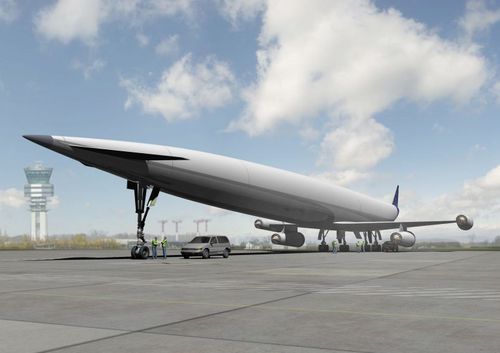
Reaction Engines précise que ceci sera possible grâce à une technologie extrêmement novatrice : un pré-refroidisseur.
Dans une vidéo, l'ingénieur en chef Alan Bond explique que l'air entrant dans le nouveau moteur "Sabre" pourrait être refroidi de plus de 1 000°C en 0,01 seconde. Cette capacité permettrait de faire tourner le moteur à réaction à un plus grand régime que ce qui est techniquement possible aujourd'hui.
Plus puissant = plus rapide. Du moins, assez pour voler à Mach 5, soit cinq fois la vitesse du son, et ceci "très facilement", affirme Alan Bond.
The Telegraph donnait plus de détails sur cette technologie dans un article datant de fin 2012 :
"Cette rupture technologique repose sur un système de refroidissement qui utilise un ensemble de tubes très fins disposés en forme de "tourbillon" et remplis d'hélium condensé pour extraire de la chaleur à partir de l'air et la refroidir à -150°C avant qu'elle ne pénètre dans le moteur.
Dans des conditions normales, l'humidité contenue dans l'air viendrait à geler, tapissant le moteur de givre. Cependant, l'entreprise a également mis au point une méthode qui empêche ce phénomène de se produire."
A long terme, l'entreprise espère pouvoir utiliser ce dispositif de refroidissement pour construire un avion qui transporterait 300 passagers et se déplacerait comme une fusée. Selon Bond, cela révolutionnerait le secteur de l'aviation à grande vitesse. "La concurrence est inexistante. Nous sommes uniques," ajoute l'ingénieur.

L'avion en lui-même mesurera 84 mètres de long et sera baptisé Skylon. Celui-ci décollerait et atterrirait horizontalement (comme un avion normal), le rendant plus facile à réutiliser qu'une fusée standard. Toutefois, un inconvénient vient s'ajouter à l'addition salée s'élevant à 1,1 milliard de dollars pièce : le Skylon n'a pas de fenêtres, une nouvelle amère pour ceux qui se réjouissaient à l'idée de voler dans l'espace.
Le système est actuellement en phase de test et des vols d'essai du Skylon sont prévus pour 2019.
Article d'Alex Davies. Traduction par Joséphine Dennery, JDN.
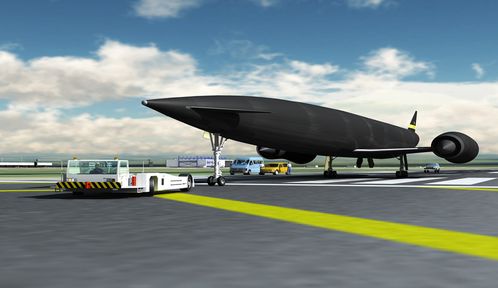
New Technology Could Make It Possible To Fly Anywhere In The World In 4 Hours
Source: http://www.businessinsider.com
British aerospace firm Reaction Engines is working on an aircraft it believes would be able to take passengers anywhere in the world in just four hours.
The vehicle would also be able to fly in outer space.
Reaction Engines says there's only one truly new technology in the aircraft that makes those things possible: the precooler.
In a new video, chief engineer Alan Bond explains that air entering the new "Sabre" engine system could be cooled by more than 1,000 degrees Celsius in .01 seconds. That ability would allow a jet engine to run at higher power than what is possible today.
More power = more speed. Enough to fly at Mach 5, five times the speed of sound, "pretty easily," Bond says.
The Telegraph explained the technology in an article in late 2012:
The breakthrough technology is a cooling system which uses an array of thin pipes, arranged in a "swirl" pattern and filled with condensed helium, to extract heat from air and cool it to minus 150C before it enters the engine.
In normal circumstances, this would cause moisture in the air to freeze, coating the engine with frost, but the company has also developed a method which prevents this from happening.
The company eventually hopes to use its cooling technology to build a plane that transports 300 passengers and flies like a rocket. It will "transform high-speed aviation," Bond says, adding, "we have no competitors. We are unique."
The aircraft itself will measure 276 feet long, and be called the Skylon. It would take off and land horizontally (like a
plane), which would make it easier to reuse than a standard rocket. But in addition to the $1.1
billion price tag for each one, there's another big downside: The Skylon has no windows, a major bummer for those excited to fly in space.
The company is currently in the process of testing the system. Test flights of the Skylon are planned for 2019.
provenant du:
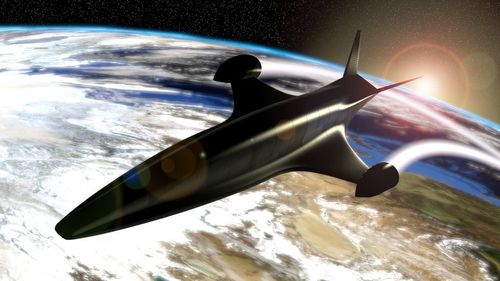
Imagine taking off from a runway as you would in a normal aeroplane but flying so high and so fast that when you unclip your seatbelt, you float around the cabin. Look out of the windows: on one side is the inky blackness of deep space, while on the other is the electric blue of your home planet, Earth.
This is no joyride for a few brief minutes of space-tourism weightlessness. Instead you are three, five or even 10 times higher than those little hops. In front of you is your destination: a space station. Perhaps it is a hotel or a place of work. You are in low earth orbit – and you've got there in far less time than it takes for a transatlantic flight.
This is the promise of the spaceplane, and it took a step closer to reality yesterday. UK Minister for Universities and Science David Willetts confirmed the government's £60m investment in Reaction Engines Ltd.
Spaceplanes are what engineers call single-stage-to-orbit (if you really want to geek out, just use the abbreviation: SSTO). They have long been a dream because they would be fully reusable, taking off and landing from a traditional runway.
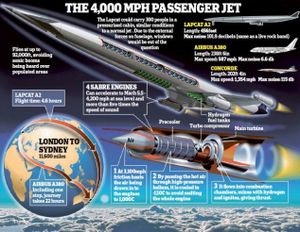 By building reusable spaceplanes, the cost of reaching orbit could be reduced to a twentieth current levels. That makes
spaceplanes a game changer both for taking astronauts into space and for deploying satellites and space probes.
By building reusable spaceplanes, the cost of reaching orbit could be reduced to a twentieth current levels. That makes
spaceplanes a game changer both for taking astronauts into space and for deploying satellites and space probes.
If all goes to plan, the first test flights could happen in 2019, and Skylon – Reaction Engines' spaceplane – could be visiting the International Space Station by 2022. It will carry 15 tonnes of cargo on each trip. That's almost twice the amount of cargo that the European Space Agency's ATV vehicle can carry.
SKYLON - Operations from Reaction Engines Ltd on Vimeo.
Traditional rockets can only reach orbit by dropping off empty fuel tanks as they go. This makes them virtually impossible to re-use because even if you could collect all the parts, they would need so much refurbishment and reassembly that it's usually quicker, easier and cheaper to build new ones.
Rockets are cumbersome because not only must they carry fuel, they also need an oxidising agent to make it burn. This is usually oxygen, which is stored as a liquid in separate tanks. Spaceplanes do away with the need for carrying most of the oxidiser by using air from the atmosphere during the initial stages of their flight.
This is how a traditional jet engine works, and making a super-efficient version has been engineer Alan Bond's goal for decades. In 1989, he founded Reaction Engines and has painstakingly developed the Sabre engine, which stands for Synergetic Air-Breathing Rocket Engines.
In late 2012, tests managed by the European Space Agency showed that the key pieces of technology needed for Sabre worked. No one else has managed to successfully develop such a technology.
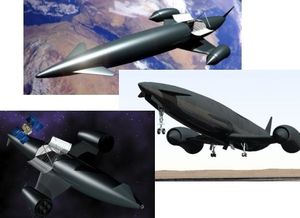 This makes
Sabre a world-leading technology and the new money will allow a full-size prototype to be made as a final test before commercial production can begin.
This makes
Sabre a world-leading technology and the new money will allow a full-size prototype to be made as a final test before commercial production can begin.
To reach orbit, Skylon will use Sabre to boost it to Mach 5. It will then close the air intakes and use a small amount of onboard oxidiser to turn the jets into rockets and boost itself to Mach 22. At this speed, roughly 7.5km/s, the craft will reach low earth orbit.
Used terrestrially, an aeroplane powered by Sabre engines could whiz you from the UK to Australia in just four hours, the same time it takes holidaying Brits to reach the Canary Islands.
Spaceplanes should not to be confused with space tourism vehicles such as Virgin Galactic's Space Ship Two. The highest altitude this vehicle will reach is about 110km, giving passengers about six minutes of weightlessness as the craft plummets back to Earth before the controlled landing.
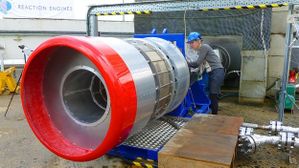 Although there is no fully agreed definition, space starts at around 100km in altitude. To have any hope of staying in orbit, you would have to reach twice that altitude. The International
Space Station orbits at 340 kilometres, whereas the Hubble Space Telescope sits at 595 kilometres.
Although there is no fully agreed definition, space starts at around 100km in altitude. To have any hope of staying in orbit, you would have to reach twice that altitude. The International
Space Station orbits at 340 kilometres, whereas the Hubble Space Telescope sits at 595 kilometres.
On the Reaction Engines recruitment web page, the company offers potential employees the chance to "join the organisation that will conceivably have the biggest impact on the aerospace propulsion industry since [inventor of the jet engine] Sir Frank Whittle's original design."
I think that might actually be an understatement. The Sabre engine could open up our access to space as never before.
Stuart Clark is the author of The Day Without Yesterday (Polygon). Find him on Twitter as @DrStuClark
